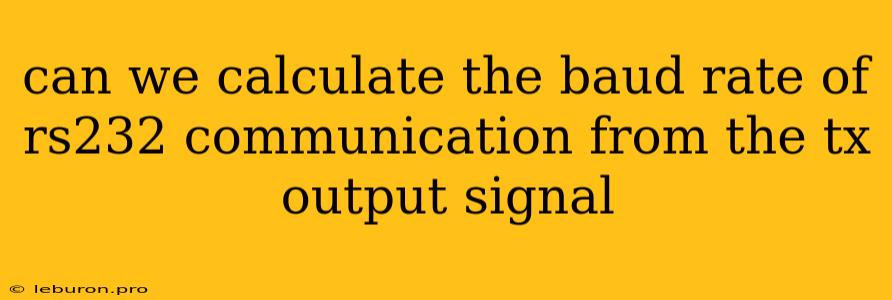Can We Calculate the Baud Rate of RS232 Communication from the TX Output Signal?
The RS-232 standard is a ubiquitous serial communication protocol used for transmitting data between devices. A key parameter in RS-232 communication is the baud rate, which represents the number of signal transitions per second. While the RS-232 standard does not mandate a specific baud rate, various standard rates are commonly used. This begs the question: can we calculate the baud rate of RS-232 communication directly from the TX output signal? The answer, unfortunately, is not as straightforward as it may seem.
Understanding Baud Rate and RS-232
Baud rate refers to the rate at which symbols are transmitted over a communication channel. In the context of RS-232, a "symbol" can be a binary bit (0 or 1). It's crucial to differentiate between baud rate and bit rate. Baud rate is the number of signal transitions per second, while bit rate is the number of bits transmitted per second. The relationship between these two is not always linear, as multiple bits can be represented by a single signal transition, especially in advanced modulation schemes.
RS-232, short for Recommended Standard 232, is a serial communication standard that defines the electrical characteristics and signaling protocols for data transmission. This standard utilizes voltage levels to represent binary data, where a positive voltage indicates a logic "1" and a negative voltage indicates a logic "0". The signal transitions between these voltage levels represent the data being transmitted.
Challenges in Calculating Baud Rate
While the TX output signal of an RS-232 communication line might seem to offer a direct window into the baud rate, several factors make accurate calculation challenging:
- Signal Complexity: The RS-232 signal is not a simple square wave with clear transitions. Instead, it can exhibit various voltage levels and transitions depending on the data being transmitted, the hardware implementation, and noise.
- Data Encoding: RS-232 can utilize different data encoding schemes, like NRZ (Non-Return-to-Zero) or Manchester Encoding, each having a distinct relationship between signal transitions and the actual data bits.
- Noise and Distortion: Real-world communication channels are prone to noise and distortion. This can introduce spurious signal transitions that complicate the analysis of the baud rate.
- Start and Stop Bits: RS-232 communication protocols often employ start and stop bits to frame the data, further complicating the calculation of the baud rate based solely on the TX signal.
Tools and Techniques for Determining Baud Rate
While calculating the baud rate solely from the TX signal is difficult, several tools and techniques can help determine it:
- Logic Analyzers: These sophisticated instruments allow for capturing and analyzing the RS-232 signal with high accuracy. They can visually display the signal waveform and provide detailed information about the data bits, timing, and baud rate.
- Data Capture and Analysis Software: Specialized software can capture and decode the data transmitted over the RS-232 line. By analyzing the timing of the data bits, it can derive the baud rate.
- Protocol Analyzers: Similar to logic analyzers but focused on higher-level communication protocols, protocol analyzers can capture and analyze the RS-232 data stream, including the baud rate.
- Baud Rate Detection Algorithms: Some hardware and software implementations utilize algorithms to automatically detect the baud rate based on the signal characteristics.
Examples of Baud Rate Calculation
To illustrate the challenges and complexities, consider two common examples:
- Simple NRZ Encoding: If we assume a simple non-return-to-zero (NRZ) encoding scheme where each bit is represented by a fixed voltage level, we could potentially calculate the baud rate by counting the number of signal transitions per second. However, even in this simplified scenario, noise and distortion could introduce inaccuracies.
- Manchester Encoding: In Manchester encoding, each bit is represented by a transition in the middle of its bit time. While this encoding provides a direct correlation between transitions and bits, the analysis requires accurate timing and interpretation of the transitions.
Conclusion
While it's not directly feasible to calculate the baud rate of RS-232 communication solely from the TX output signal due to complexities in the signal, encoding, and noise, dedicated tools and techniques can help determine this crucial parameter. Understanding these challenges and utilizing appropriate tools is essential for accurately analyzing and interpreting RS-232 communication data.
